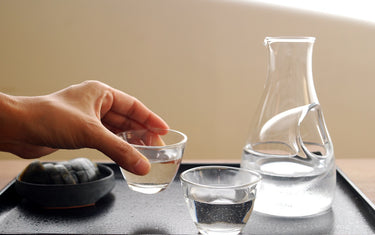There are various kinds of liquor including brewed liquor, distilled liquor and mixed liquor. Liquor is an important culture reflecting local customs and history.
Japan has representative liquors. “Nihonshu (Japanese sake)” is one of them.
Today we are going to introduce Nihonshu, a traditional Japanese liquor.
What is Nihonshu?

Nihonshu is a brewed liquor mainly made from rice and categorized into several types – Junmaishu (pure rice sake), Honjozoshu (authentically-brewed sake), Ginjoshu (brewed by low temperature fermentation from white rice).
In Japan, people have Nihonshu not only for pleasure in daily life but also for celebration such as weddings and Shinto ceremonies of purifying a building site. Liquor is believed to be a a protective charm.
Each type of Nihonshu has its own flavor and taste - mainly natural flavor of raw material and additional flavor that was produced in manufacturing process, such as sharpness and fruitiness.
Nihonshu Enjoyed at Different Temperatures

There are several ways to enjoy Nihonshu according to seasons or occasions. Nihonshu is often used for cooking to enrich smell or flavor. It is good to heat Nihonshu in winter while cool it in summer.
What is more interesting is how Nihonshu is called will also vary depending on its temperature.
Reishu (cold Nihonshu)
Reishu is cold Nihonshu cooled in a refrigerator. It would be good to cool not only Nihonshu but also a sake glass or sake server together in a refrigerator. This is appropriate for summer and provides sharp and refreshing taste.
Hiya (Nihonshu at room temperature)
Hiya is Nihonshu at room temperature. Hiya is good to have with with meals or for those who want to enjoy natural flavor and taste of Nihonshu. Especially when having prime quality Nihonshu, it is recommended to have it at room temperature so that it tastes best.
Nurukan (lukewarm Nihonshu)
Nurukan is lukewarm Nihonshu. Japanese people have it after taking a bath, or more often in fall through winter. Having Nihonshu at warm temperature is good for stomach and intestines. Also, this is the best way to have sweet Nihonshu so that you can fully enjoy its rich flavor.
Atsukan (hot Nihonshu)
Atsukan is hot Nihonshu warmed up to 50℃ or so. Japanese people often have it in winter to warm body. Also, Nihonshu becomes milder when warmed up, and this is good for beginners. It goes well with meals, especially hot pot, stew, etc.
How to Enjoy Nihonshu

You should enjoy unique smell, flavor and taste of each Nihonshu. You can enjoy Nihonshu more and experience the profound world of Nihonshu if you use Japanese sakeware such as Tokkuri (sake server), Ochoko (small sake cup), and Guinomi (sake cup). Nothing could be better than having special sake with special sakeware on special anniversaries or celebrations. Sakeware is good for gifts as well.
There are lots of traditional and historical, elegant sakeware in Japan. It would be fun to make your own collection!
Summary
Each Nihonshu has its own feature, smell, flavor or texture that vary depending on raw materials or manufacturing method. Also, there is a rich variety of sakeware. The profound world of Nihonshu is always exciting and never get you bored.
Why don’t you step in there to experience authentic Nihonshu firsthand and trace the history and tradition of Nihonshu?













